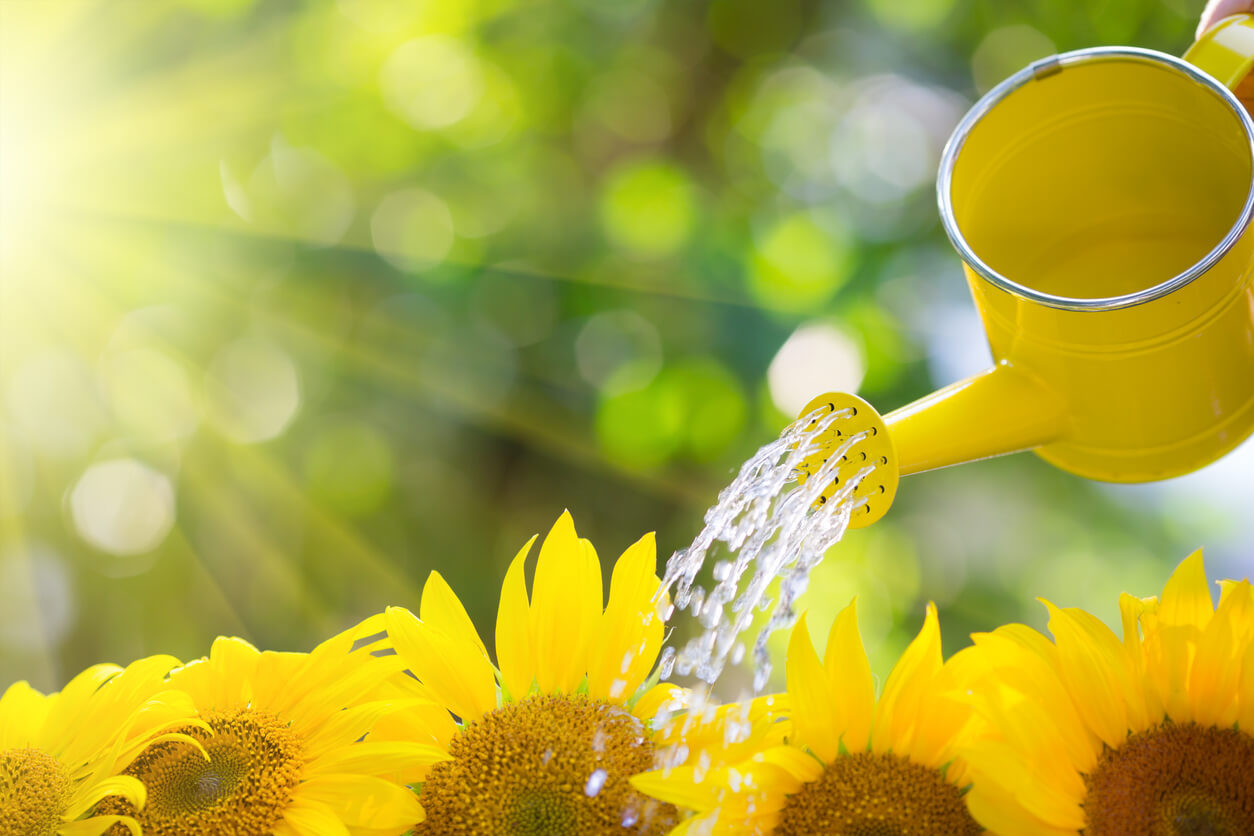
Watering can pouring water onto sunflowers
Watering your sunflower plants
As with any plant, watering your sunflowers is an important consideration. Once your sunflower plants have started growing, you’ll want to keep them consistently watered, but not soaked. About an inch of rain every seven to 10 days is sufficient. Use a practical rain gauge to make it easy to keep track of this. A less precise but easy method is to poke your finger down into the soil a couple inches. If it’s dry, water your plants.
If you don’t get enough rain, you can water once a week. Don’t over-saturate the roots, because dry roots are healthier than soaked ones. A good soaking once a week during dry spells is plenty.
Above all, don’t overwater your sunflowers. Sunflowers don’t like wet feet. And interestingly, giving your sunflowers just the right amount of water will encourage the taproot to reach farther down into the soil to pull up more nutrients.
If you miss a watering or two, it won’t be the end of your sunflowers. The plants may not grow to their optimal height and the flowers may not reach their maximum size, but they’ll still be beautiful.
If you’ve mulched, that will help keep the soil around the roots moist and cool. That keeps the plant from drying out between waterings. You can also plant some low-growing companion plants like chives or marigold to shade the roots—and keep some pests at bay!
Early morning is the best time of day to water your sunflower plants. Avoid watering during the evening or night. And always water close to the ground. Avoid splashing to help reduce the risk of fungal infections.
Weeding your sunflower plants
When it comes to weeding around your sunflower plants, early and often is best. If you’ve used weed-free soil and well-rotted organic matter, and laid down mulch, you shouldn’t have a big weed problem.
Properly preparing your soil is an excellent preventive measure against the emergence of weeds. When you till or cultivate the area where you’ll plant your sunflowers, remove weeds and debris. You’ll likely find that the first few weeks after planting are the only time you’ll be pulling up weeds around your plants.
A good natural weed deterrent is a companion plant, like chives or marigolds, which can claim the space weeds might otherwise take. Plus, chives and marigolds are natural pest repellents. See our Companion Plants for Sunflowers section for more suggestions.
If weeds spring up around your sunflowers during the growing season, work the soil around the base of the plants with a hoe—only deep enough to kill the weeds and not damage the plant’s roots.
Fertilizing your sunflower plants
The most important thing to remember about fertilizing is that you should do it based on a soil test. Then choose a fertilizer that supplements any nutritional deficiencies in your soil.
Sunflowers are heavy feeders, so it’s important to give them some good organic compost in the ground at planting time. Use a light side dressing of a 5-5-5 fertilizer when the plant’s first true leaves emerge, and another light dressing when the flowers start to form. When in doubt, back off on the nitrogen, since too much could spur excess leaf growth at the expense of the flowers.
When applying fertilizer, remember to feed the soil rather than the plant; that’s why we call it a side dressing. And be careful not to over-fertilize, which could leave your sunflowers susceptible to pests and disease.
Check your soil’s nutrients every year, and only apply nitrogen to mature trees if the soil needs it. Remember to keep the area clear of weeds, as weeds will compete with your trees for nutrients.
Deadheading your sunflower plants
Sunflower plants don’t really need pruning, but multi-headed varieties can benefit from deadheading. As flowers mature on the plant, trim them off close to the main stem and use them as cut flowers indoors or toss them somewhere a good distance from your growing sunflowers for wildlife to enjoy.
You know a sunflower is past its usefulness as part of a bouquet when the head droops over. You’ll notice that the flower ray petals are also droopy or have fallen off, and the back of the flower may be looking a little brown.
Deadheading serves two main purposes: It relieves the plant of the need to send energy to that that flower so it can focus on the flowers that are still growing, and it gives the plant a neater appearance.
If the variety you’re growing has a large seed head, you can brush off the tiny disc flowers and hang the sunflower head in a dark, warm, dry spot until the seeds are loose. Then you can decide who gets the seeds: the birds, other wildlife, or you.
How often do you water, weed, deadhead, or fertilize your sunflowers? Have you faced any challenges with your sunflower plants? Please comment below and share your experiences.


 Previous
Previous

